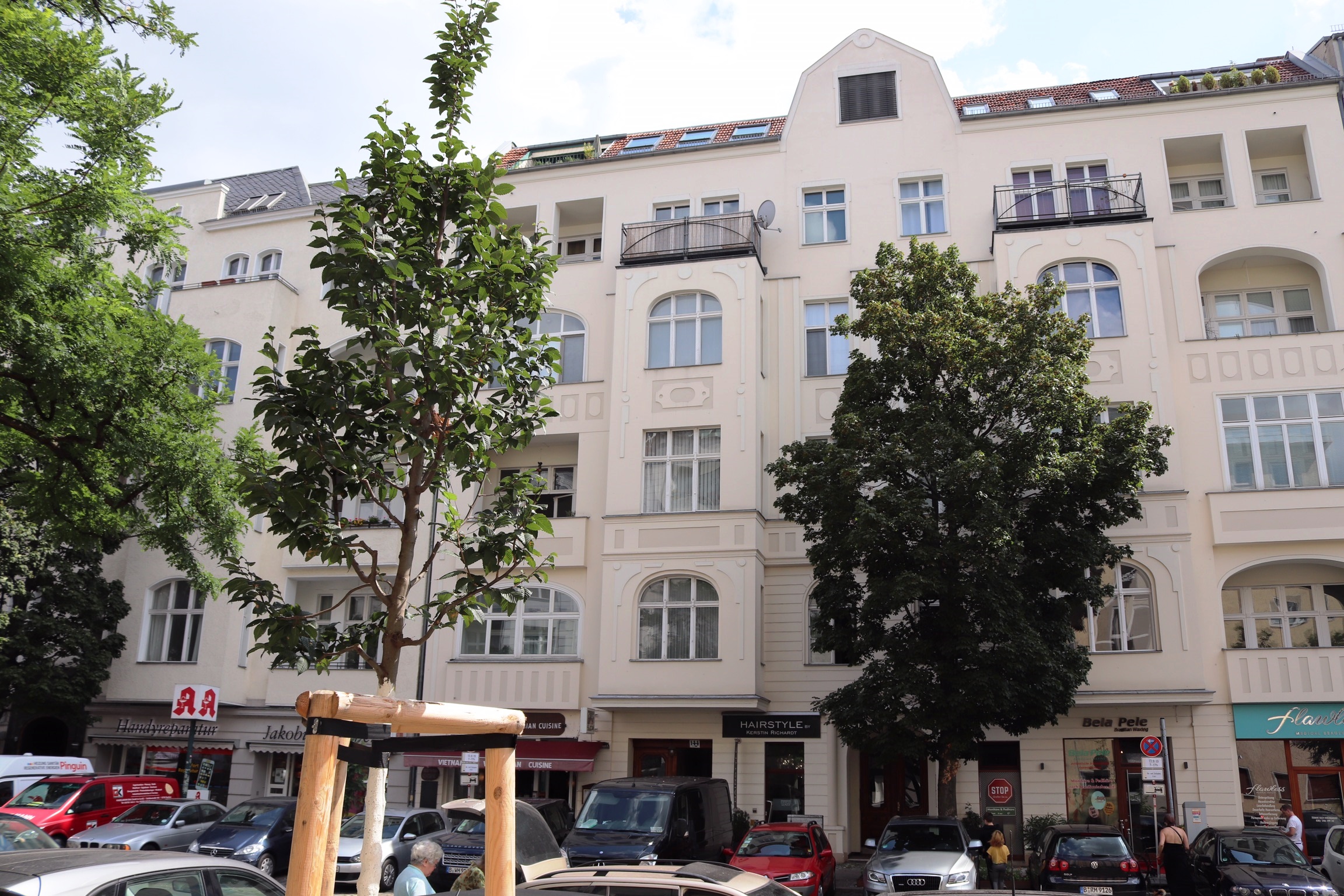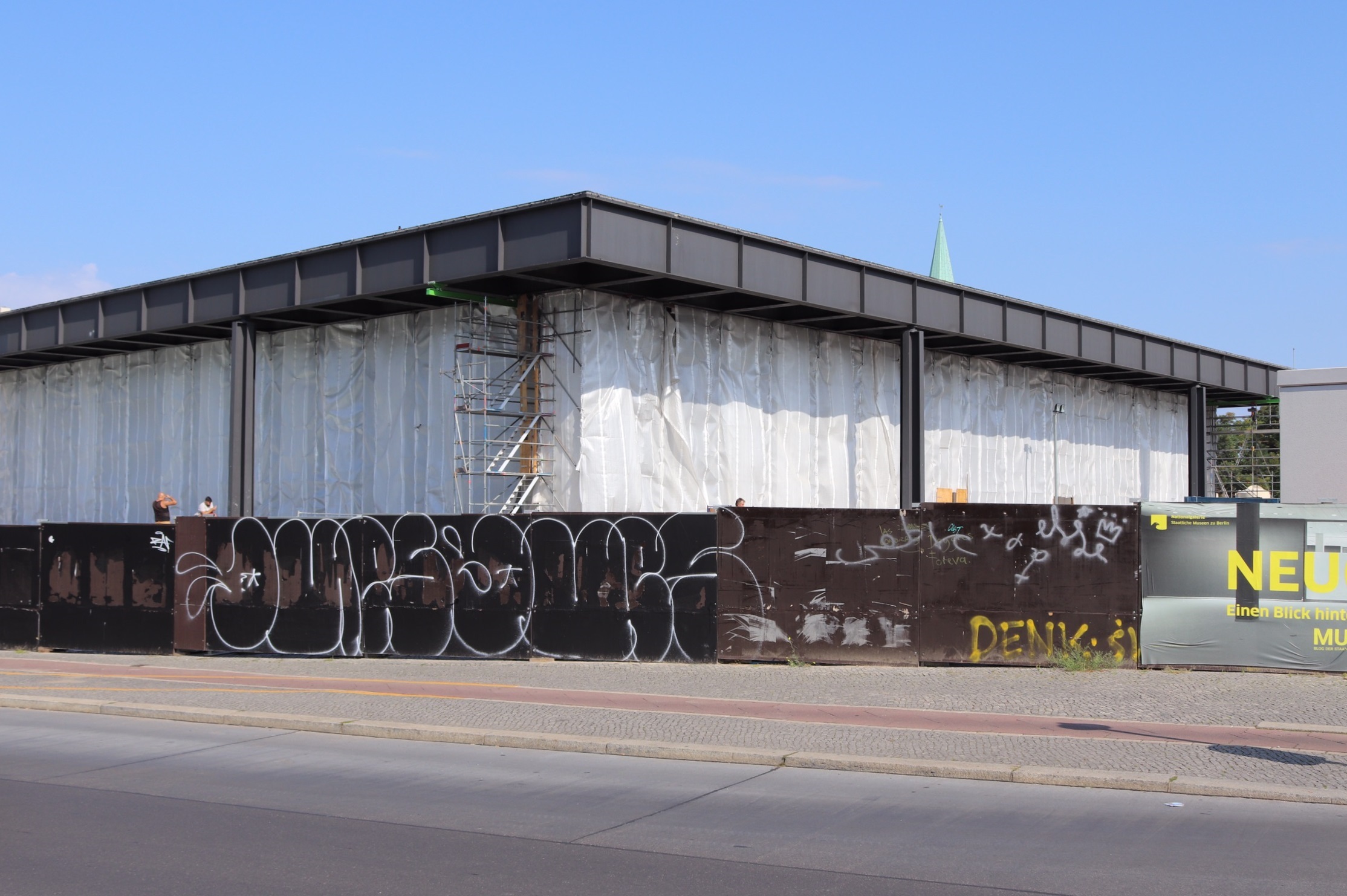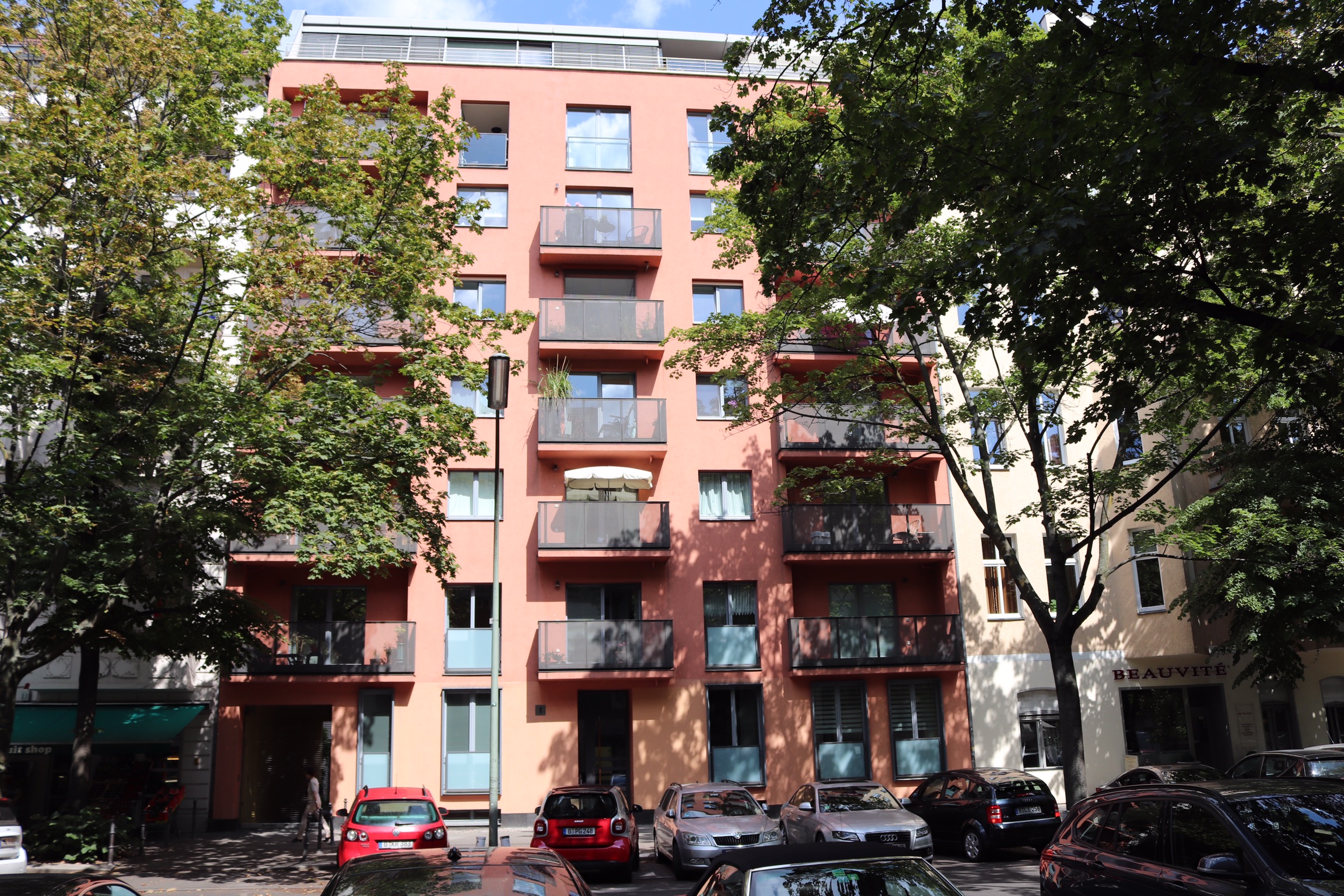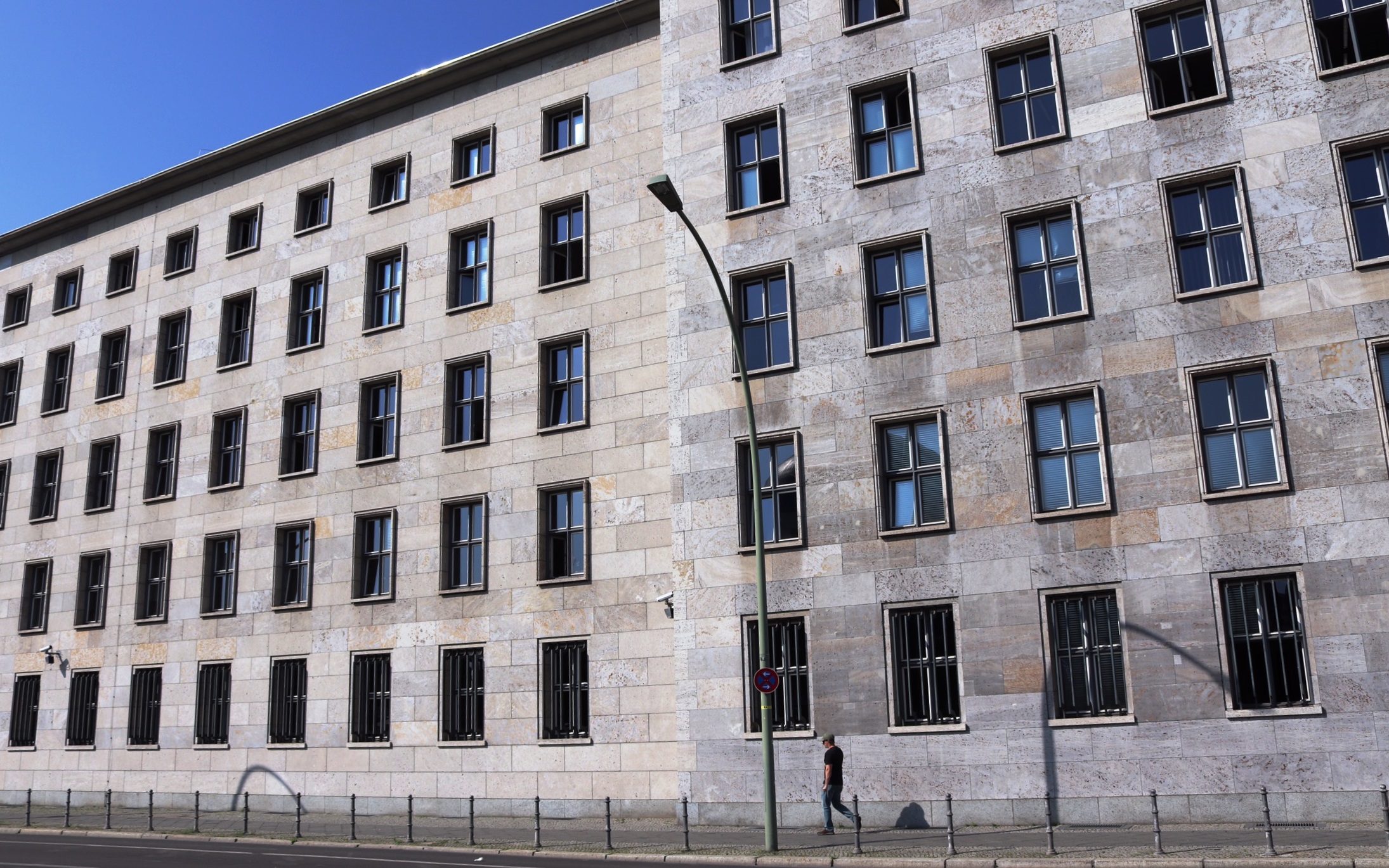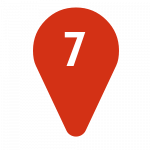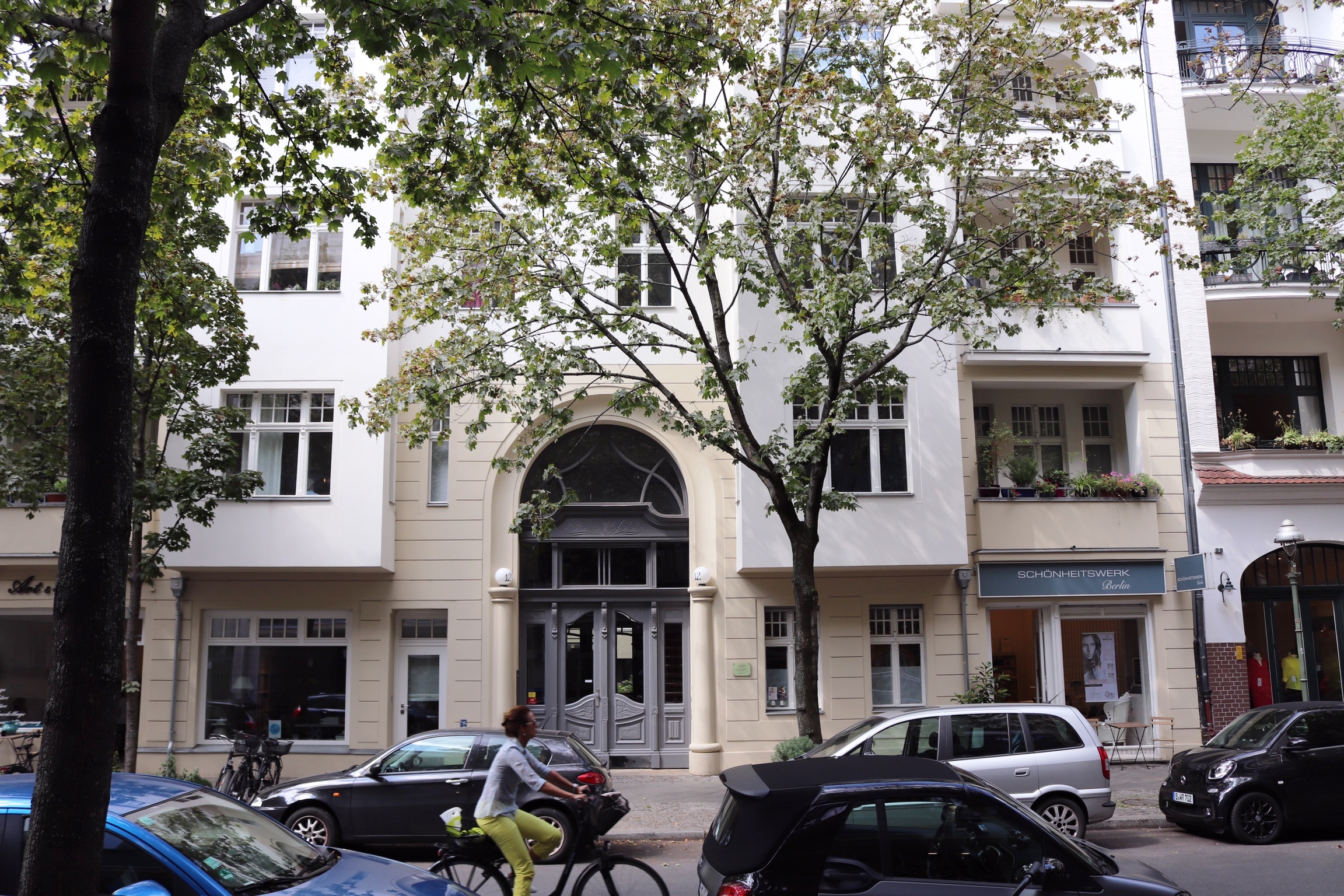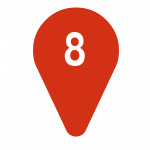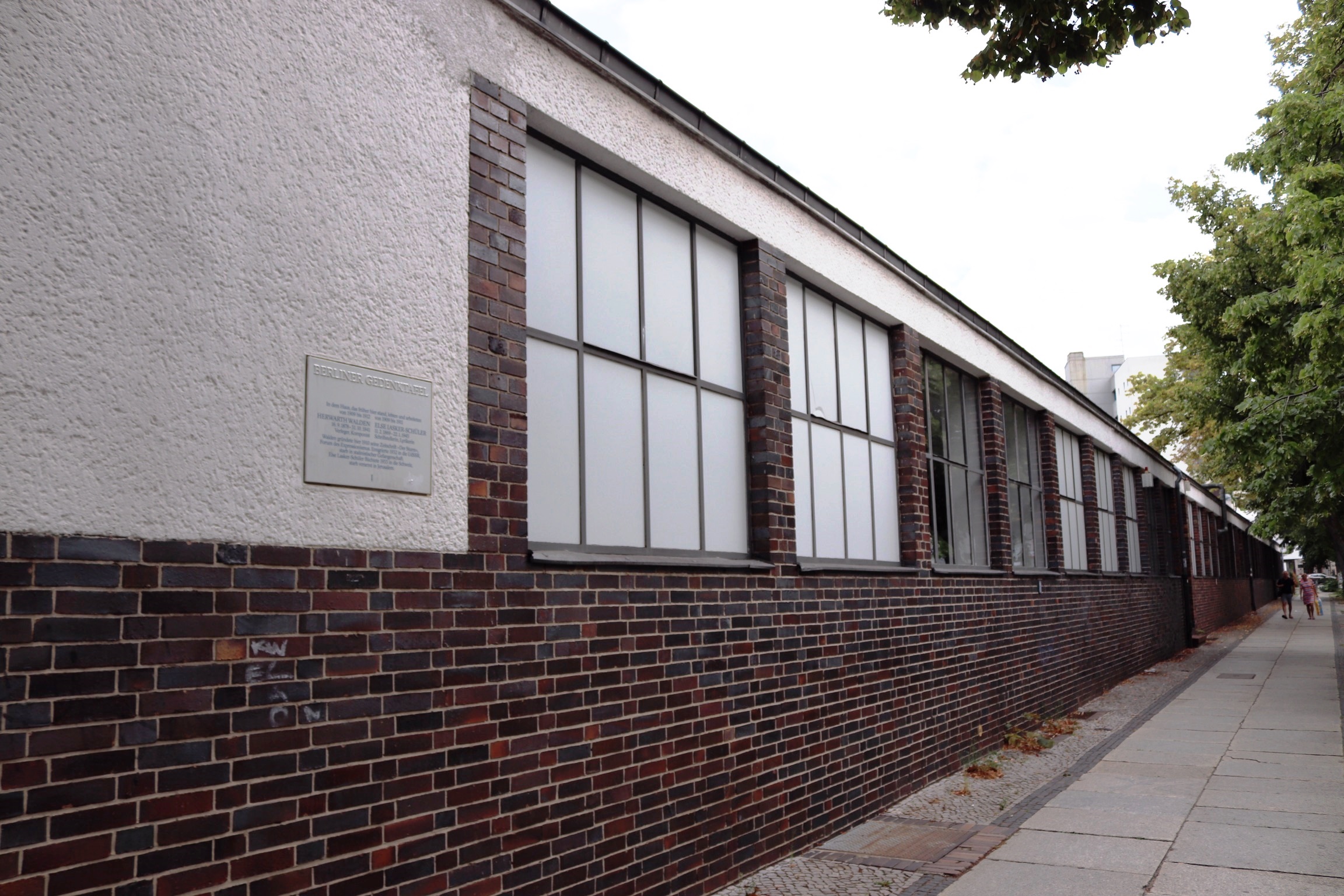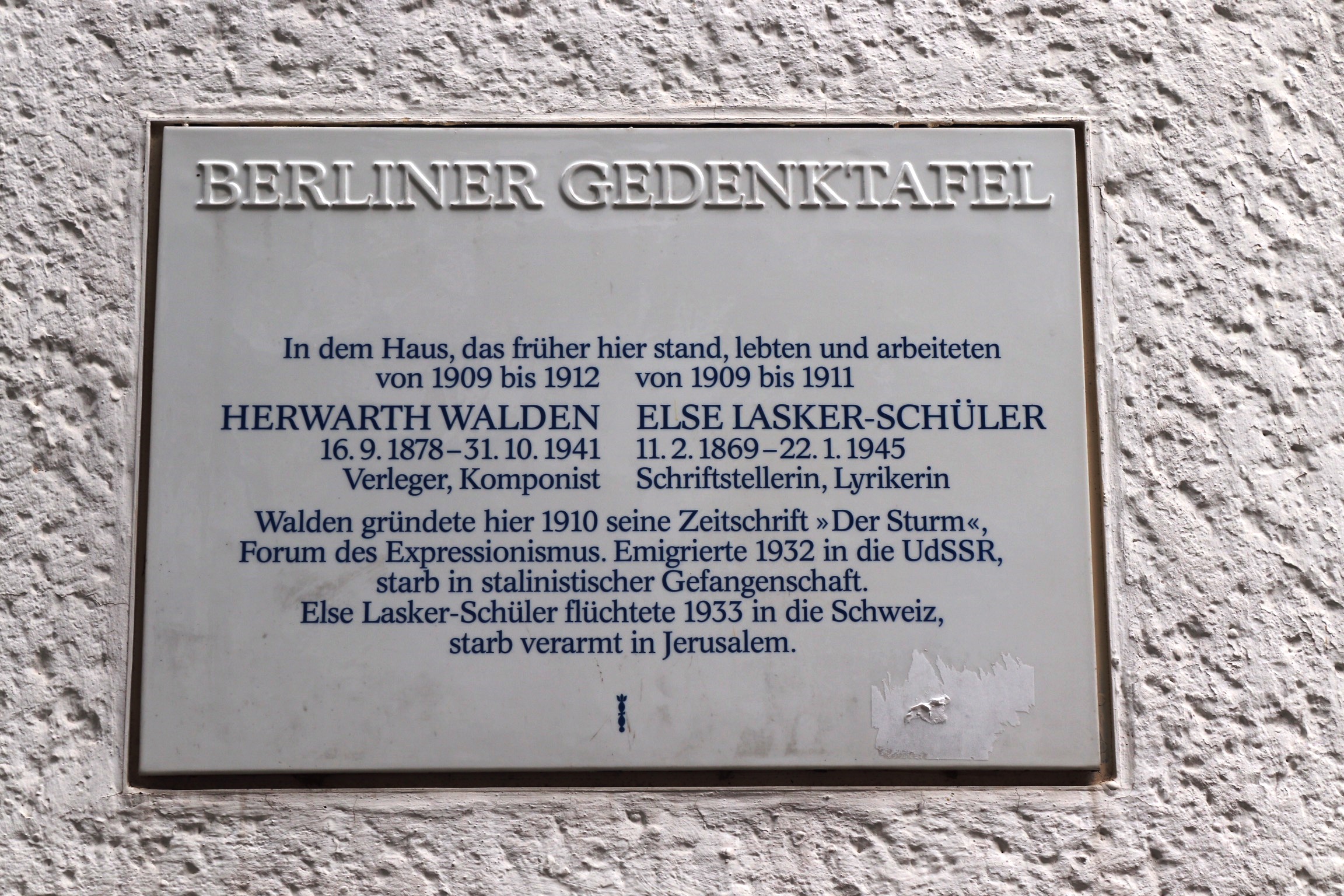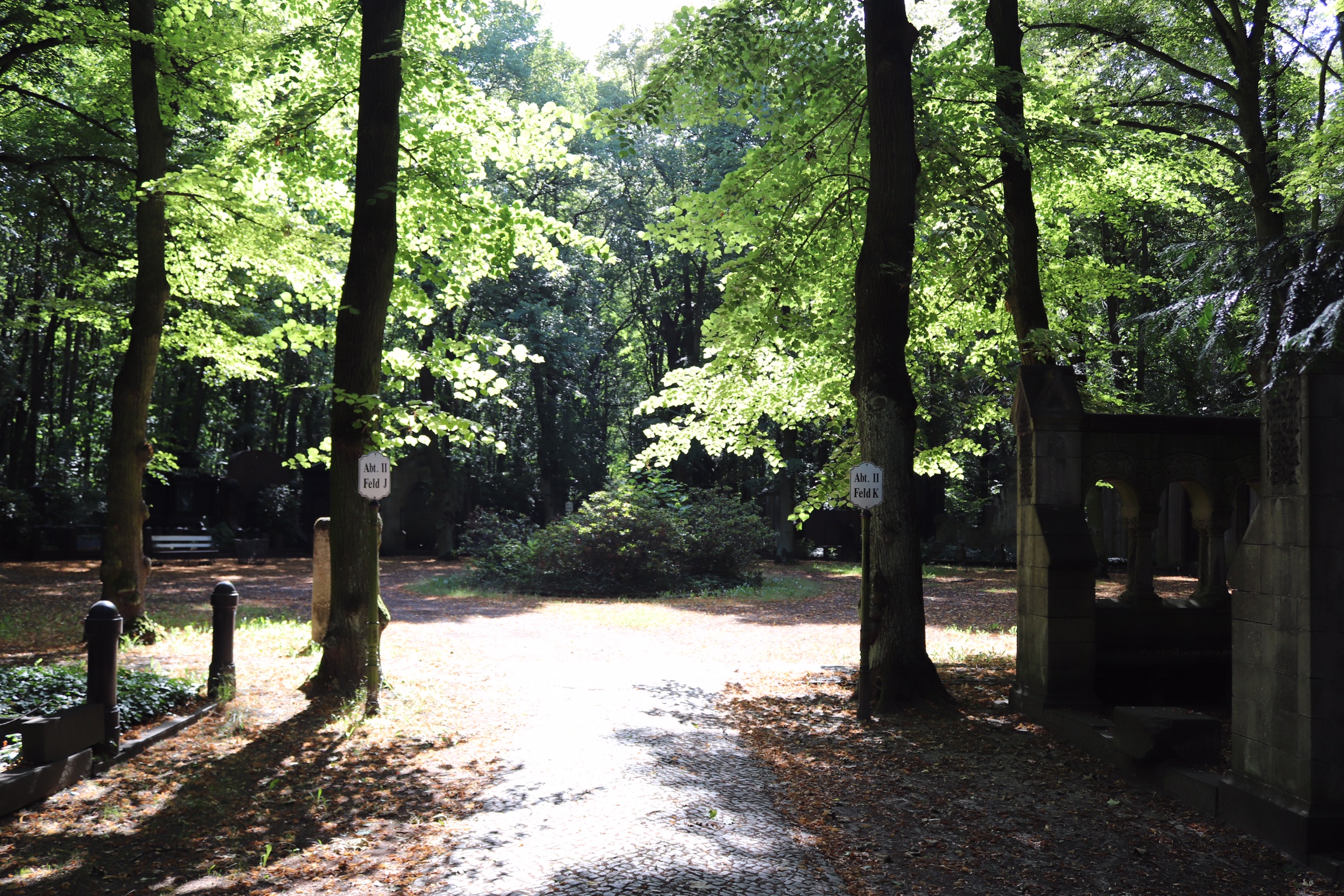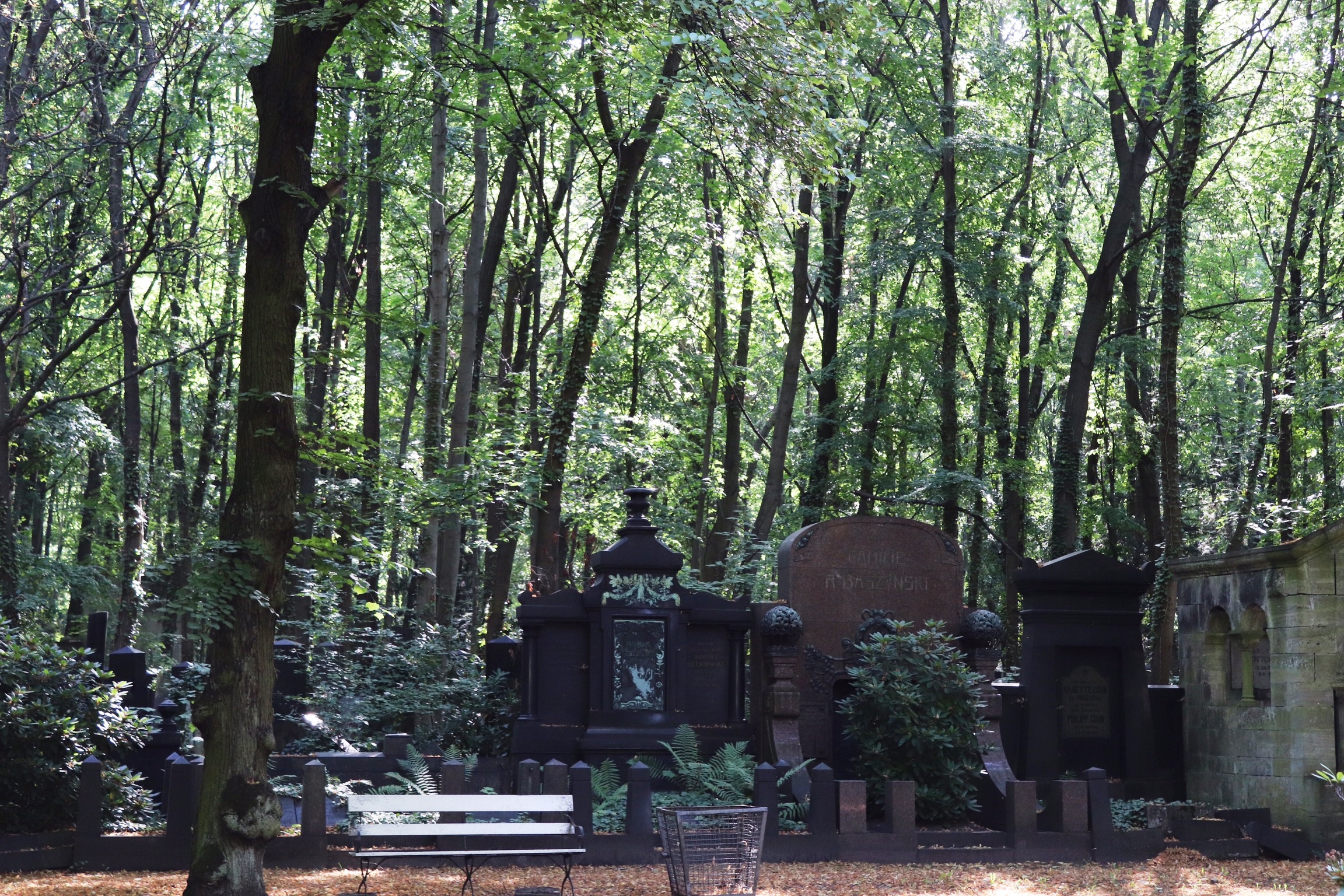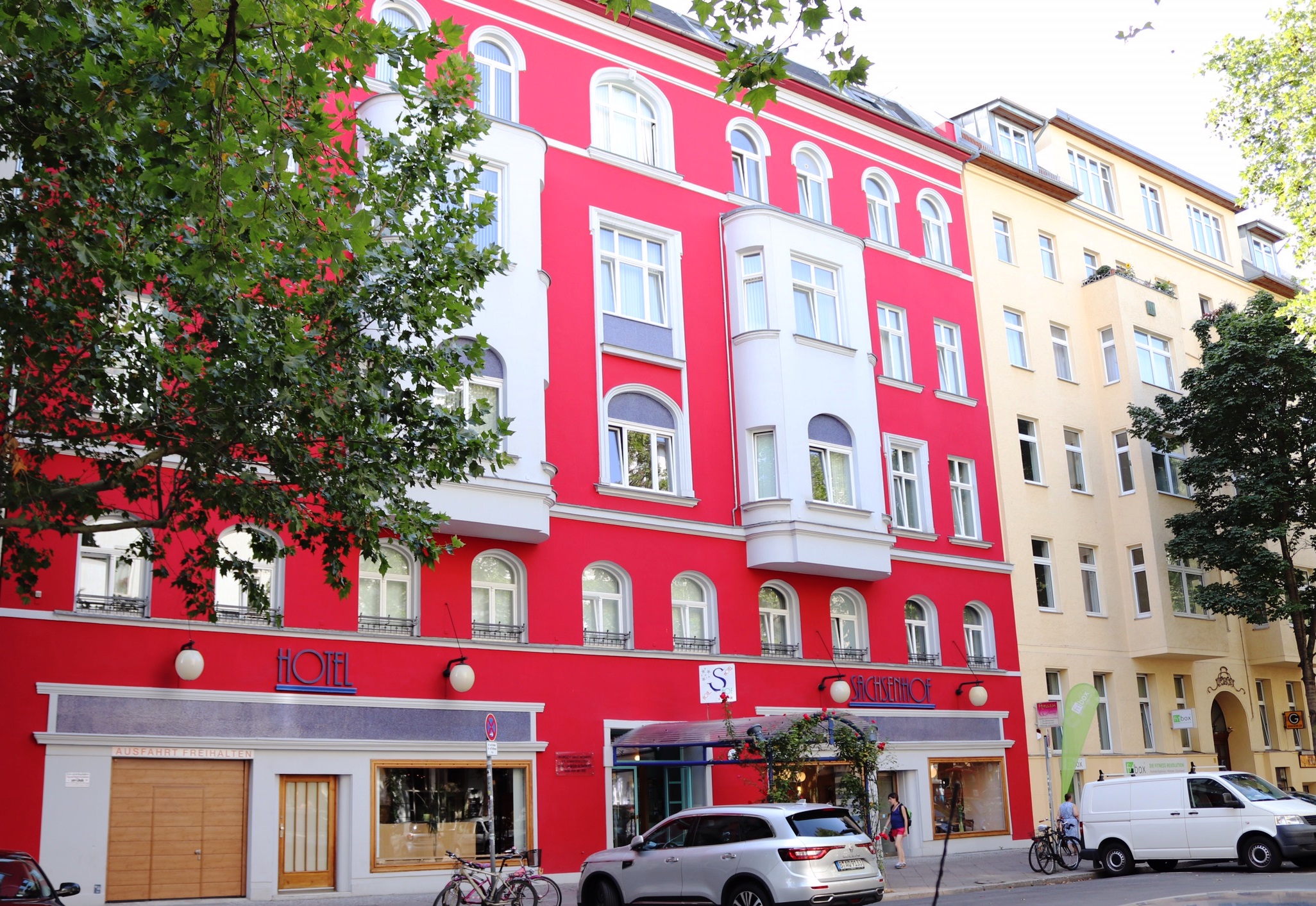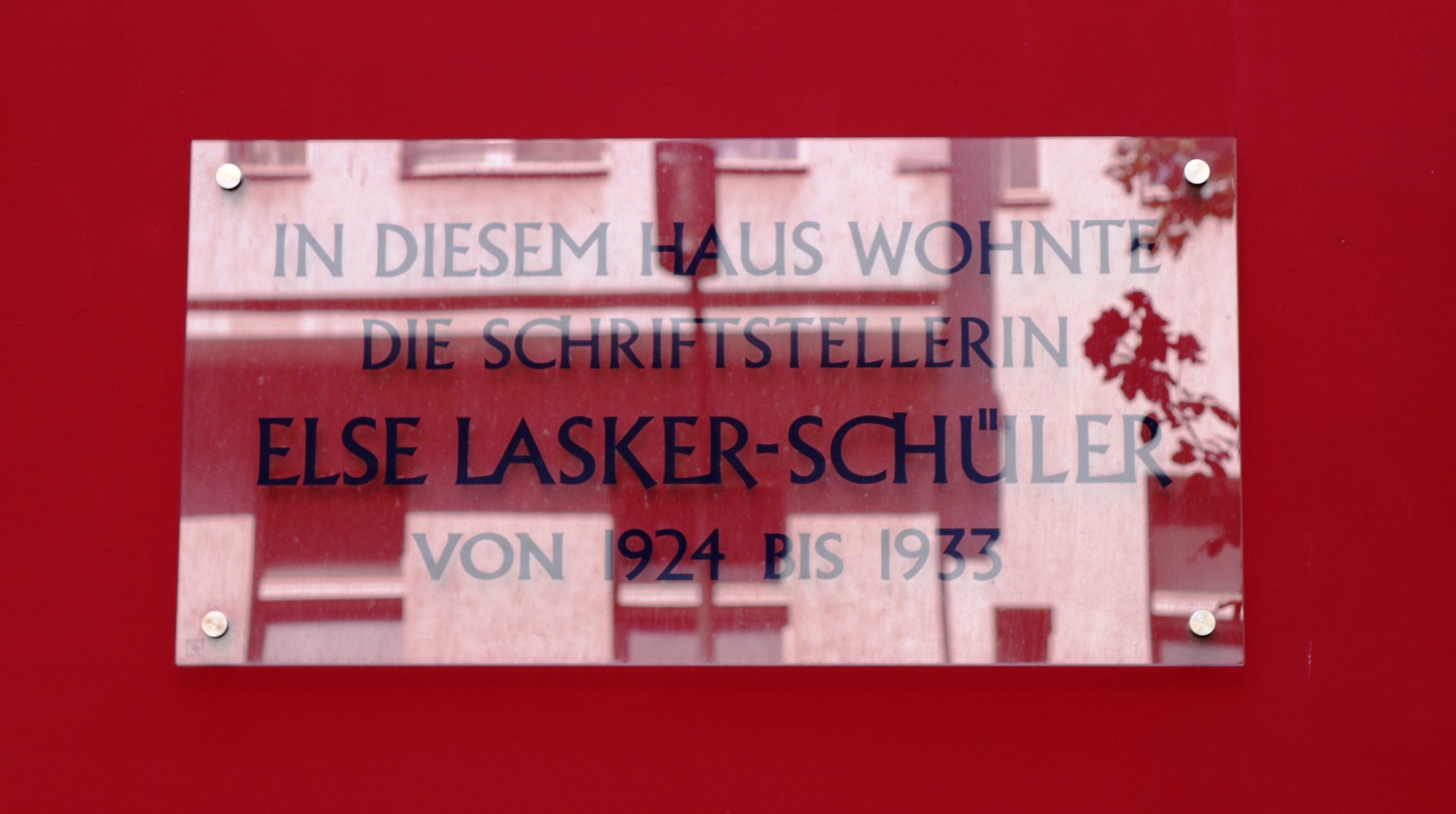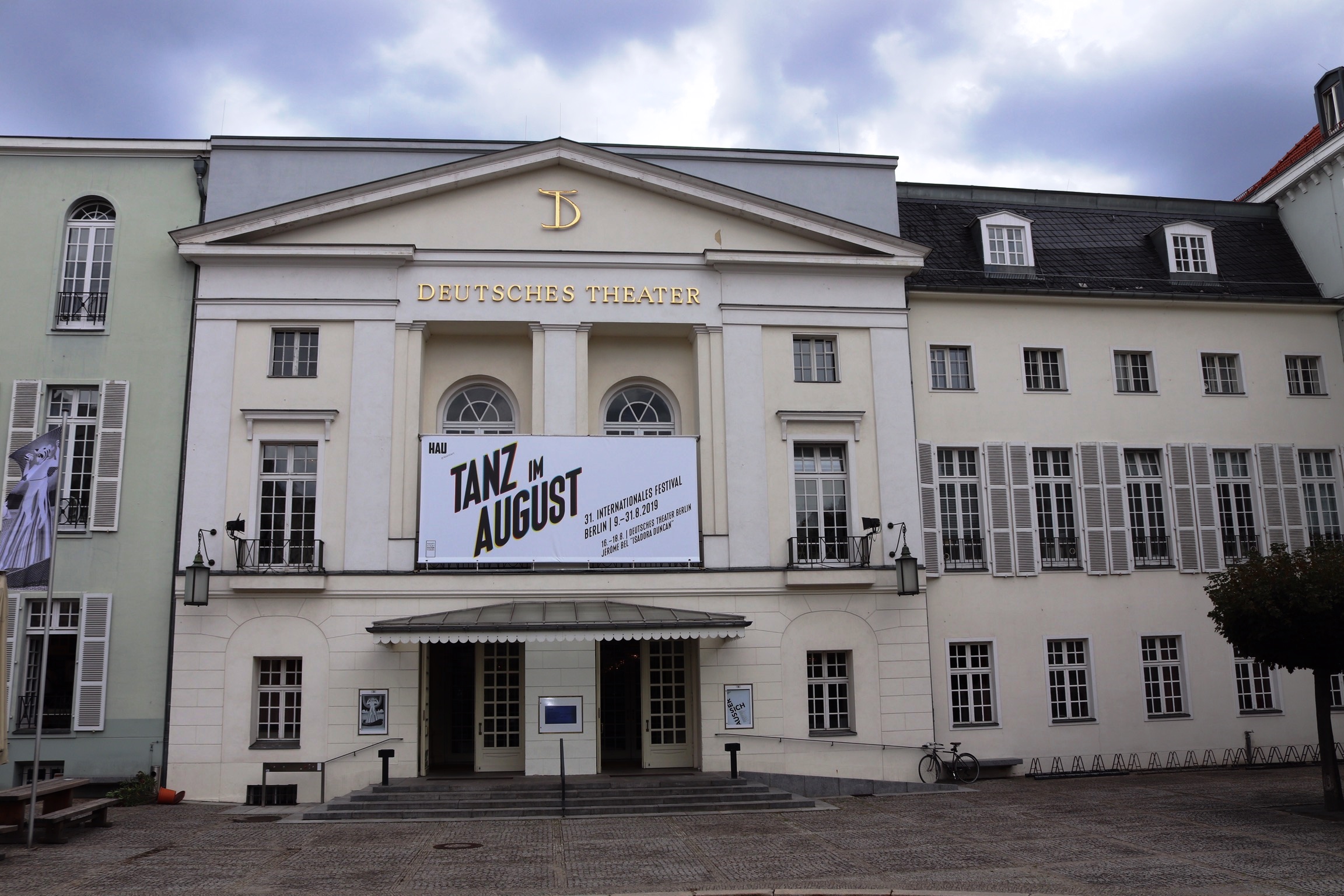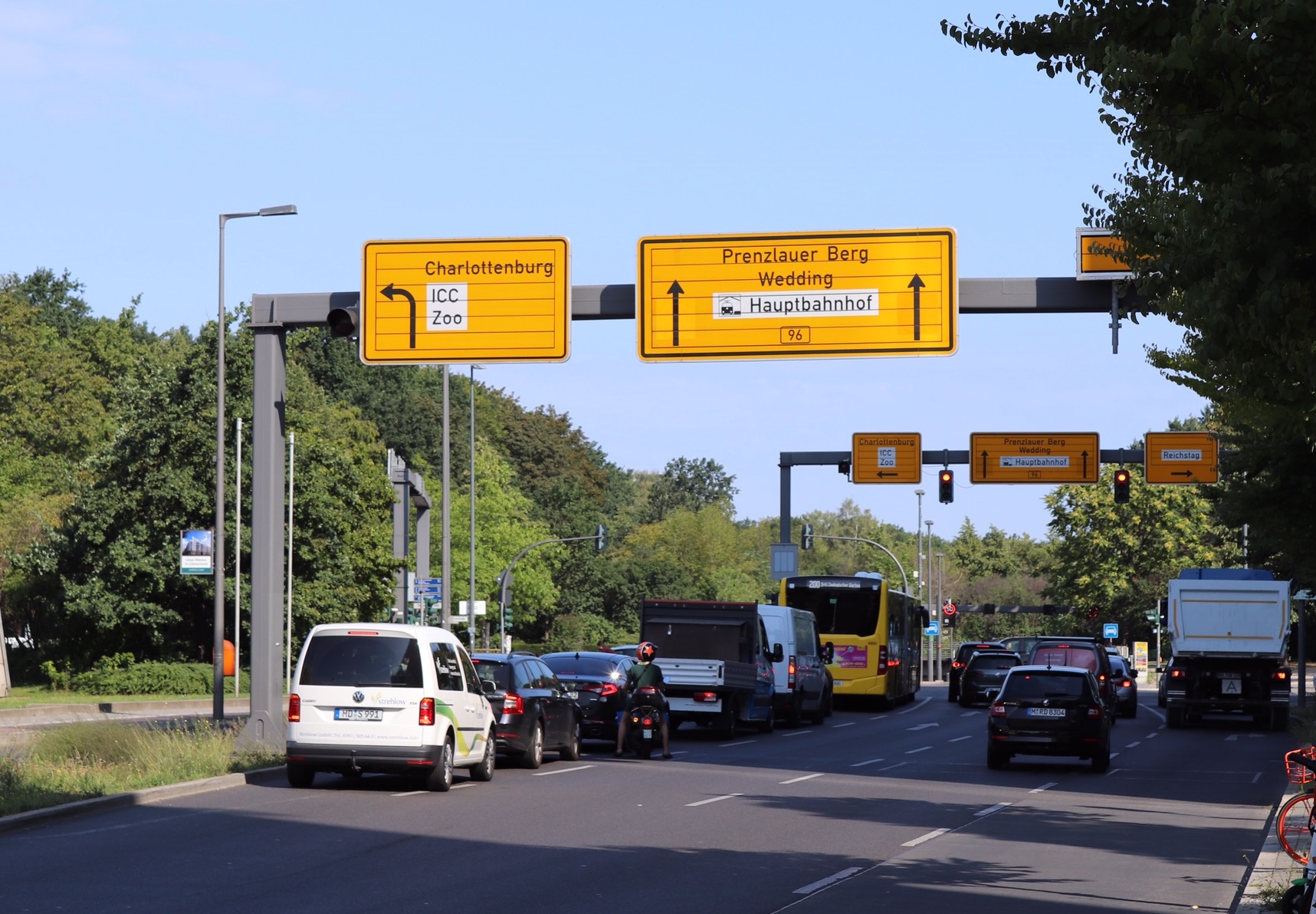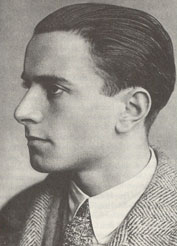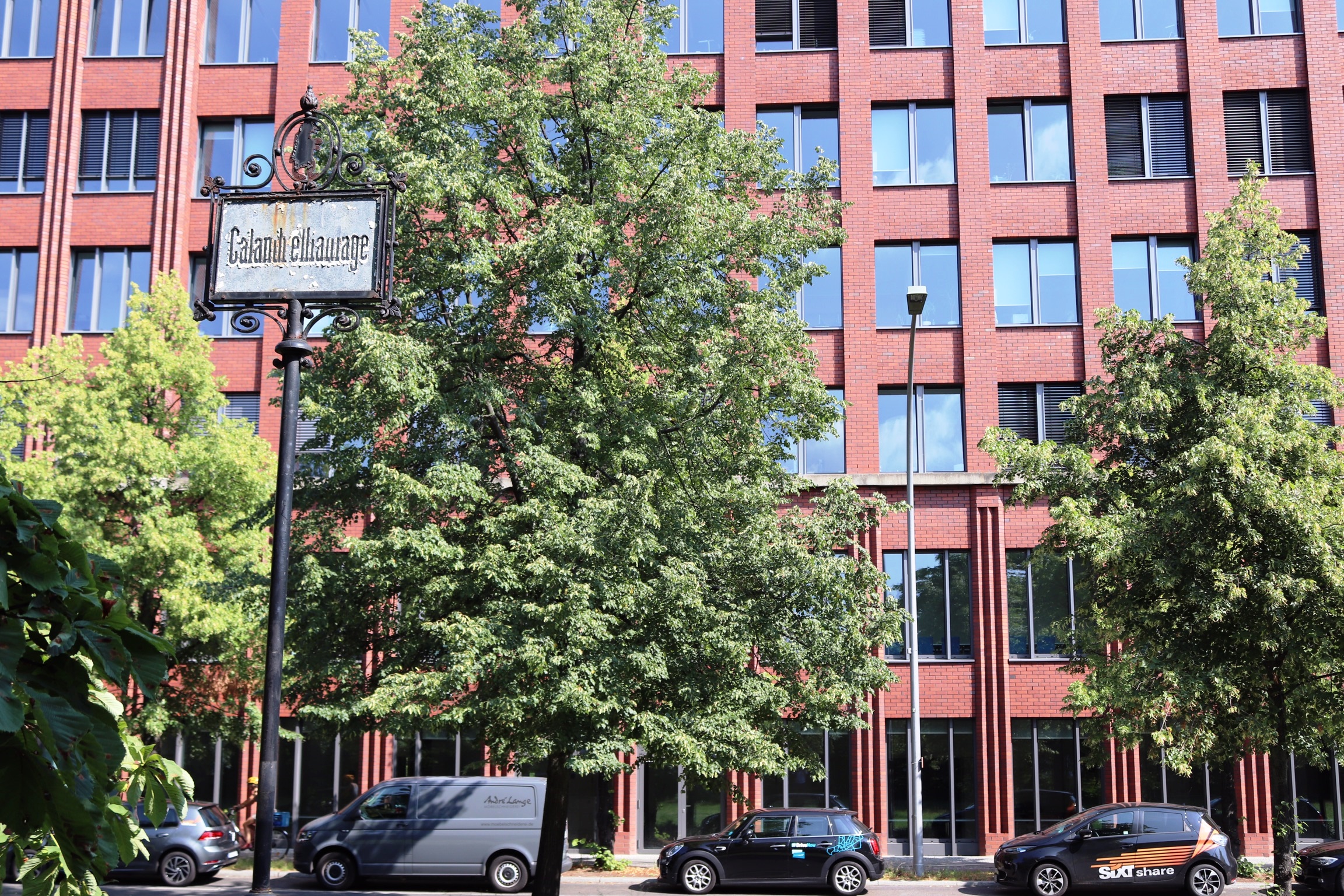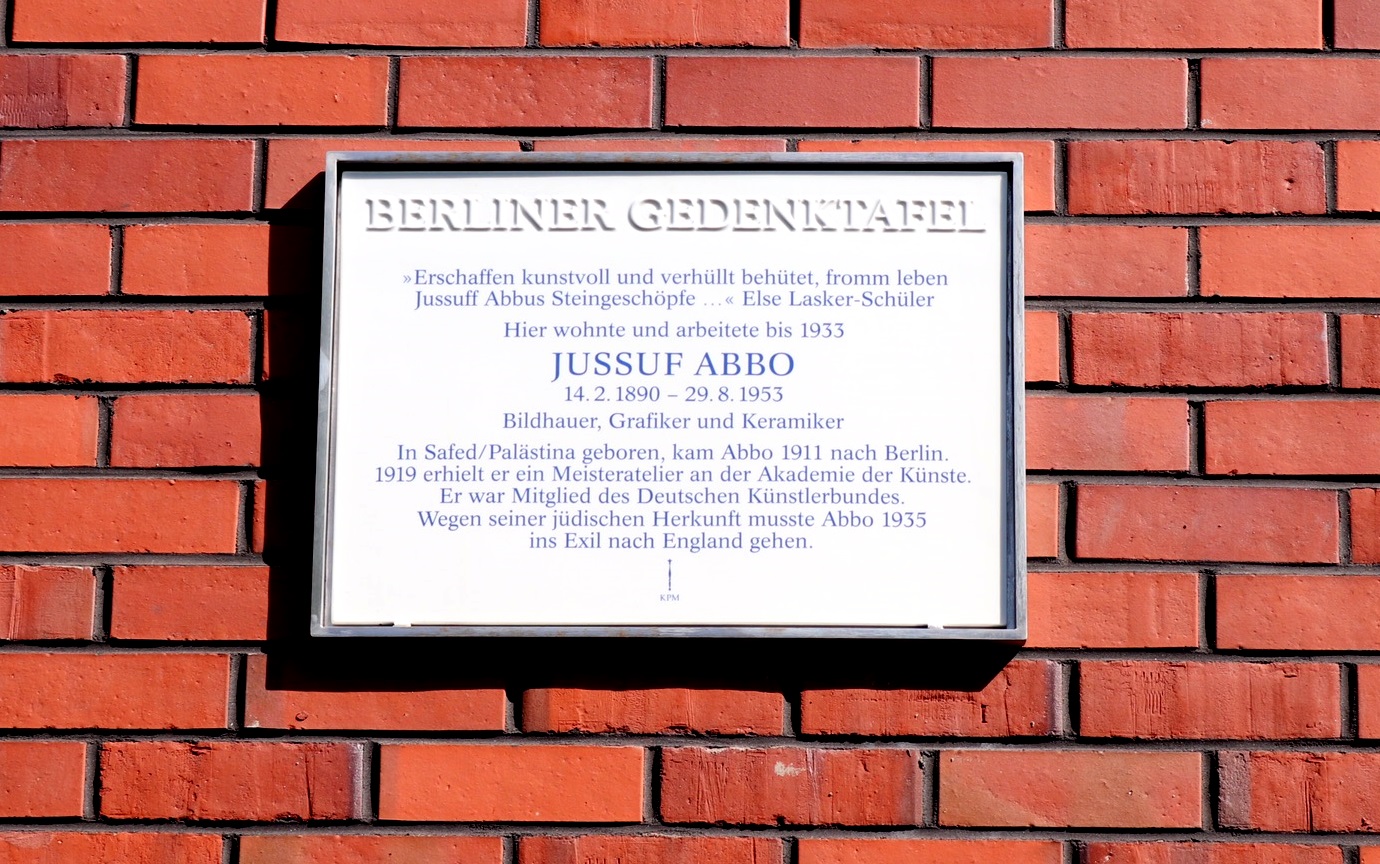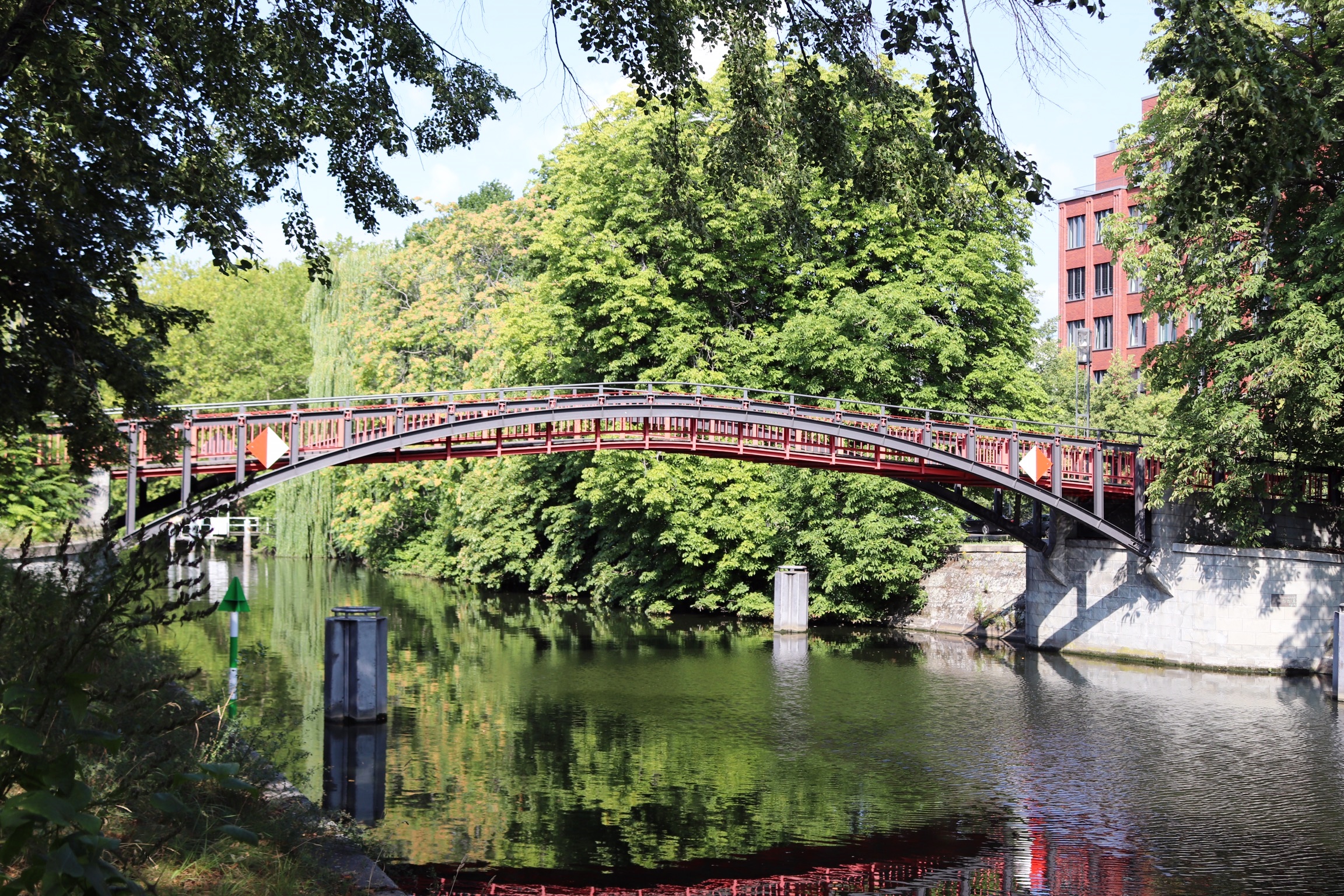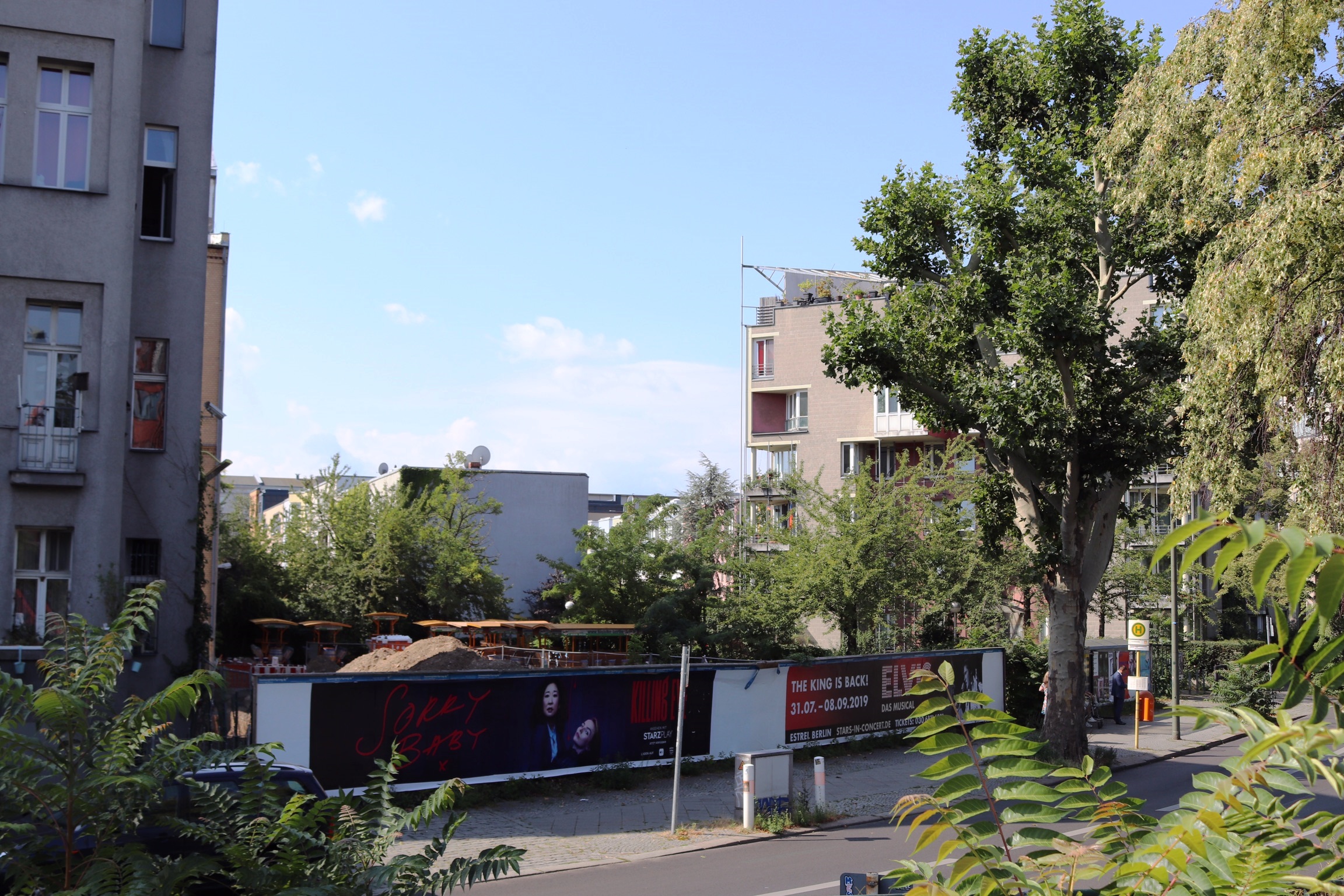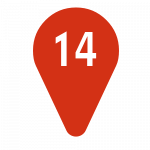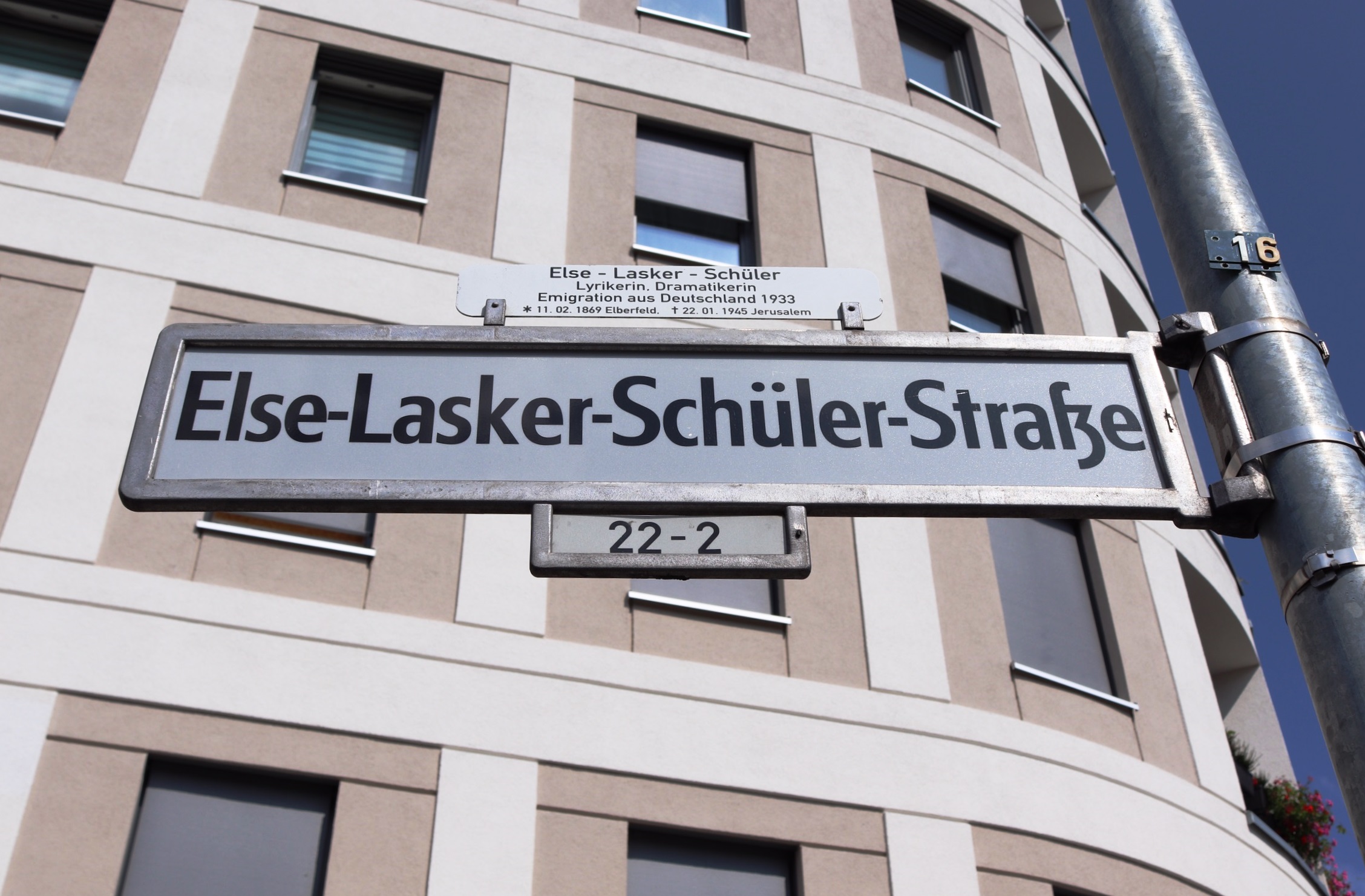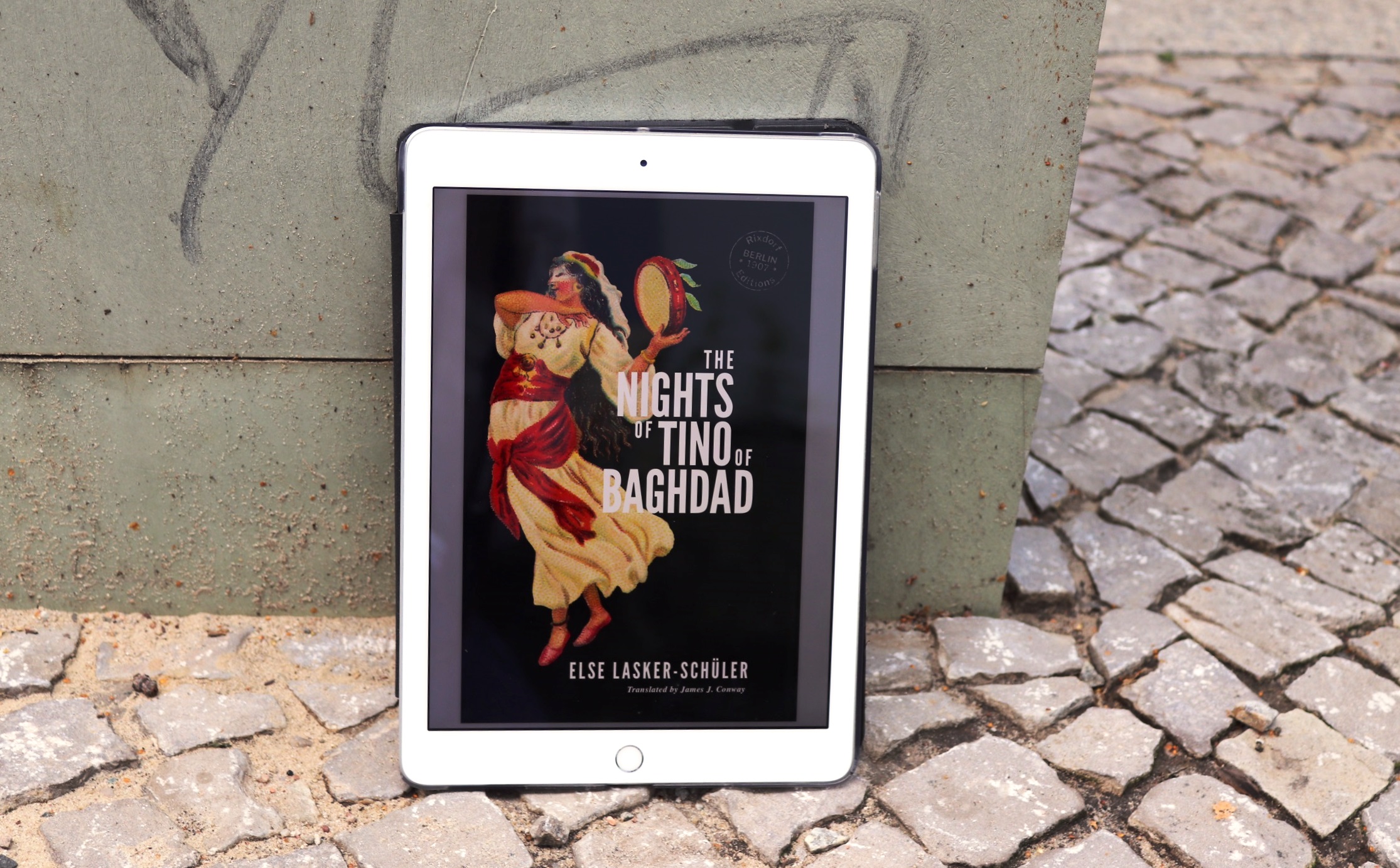Writer Else Lasker-Schüler was born in Elberfeld (Wuppertal, in the Rhineland) in 1869 and died in Jerusalem in 1945, but her home for the majority of her adult life, as well as the stage for her creative personae and the crucible of most of her greatest works, was Berlin. She arrived in 1894 with her first husband, Berthold Lasker, but within less than a decade she had divorced and then married Herwarth Walden (né Georg Levin), by which time she was a fixture of bohemian Berlin. Before World War One she had established her uncompromising artistic vision and released some of her most important publications. From her hotel room in Schöneberg she was witness to the entirety of the city’s fabled Weimar period, before she was forced into exile in 1933. And it was in Berlin that she gave birth to her only child, and nursed him to his death just 28 years later.
Else Lasker-Schüler in 1907, the year she published The Nights of Tino of Baghdad
In this, the 150th year since her birth, prompted by my translation of Lasker-Schüler’s The Nights of Tino of Baghdad, and further inspired by Jörg Aufenanger’s recent book Else Lasker-Schüler in Berlin, I set out to find the sites associated with the writer’s time in the capital and record how they looked in 2019. Many of the buildings in which she lived or spent time were destroyed during the Second World War, but these erasures themselves form a poignant memorial to a writer forced to absent the city she loved, eradicated from its cultural life at her moment of greatest renown.
Much of her activities in Berlin were encompassed within the bounds of what was then broadly termed the ‘New West’ – an expansive, orderly arrangement of largely bourgeois neighbourhoods with tree-lined streets which presented a stark contrast to the cramped and crooked laneways of the capital’s historic heart.
Here, in more or less chronological order, are some of the key stations of Else Lasker-Schüler’s life in Berlin.
Brückenallee
In 1894, Else Lasker-Schüler moved with her husband Berthold Lasker from Elberfeld and settled in Brückenallee in the central Berlin district of Hansaviertel. Lasker, a physician and chess master, hired a studio in the same street where his wife took art lessons. Nestled in a loop of the River Spree, the Hansaviertel was a prestigious neighbourhood at the time although it retained a creative edge, numbering both government ministers and artists among its residents, and offering two synagogues to serve its large Jewish community. Lasker-Schüler departed after the breakdown of her marriage in 1899, and gave birth to her son Paul that same year; Lasker was not the father.
This area was almost entirely destroyed during the Second World War and the streetscape radically altered when it became a showcase of high-rise modernism including designs by the likes of Walter Gropius, Oscar Niemeyer and Alvar Aalto – West Berlin’s response to progressive urban development on the other side of the Wall. The building that stands where Lasker-Schüler once lived on Brückenallee, now Bartningallee, inhabits a somewhat less exalted class of post-war architecture.
Neue Gemeinschaft
Leaving material security behind, Lasker-Schüler embarked on a new life in the new century and joined the New Community (Neue Gemeinschaft) in 1900, her first major contact with bohemian, literary Berlin. This idealistic group with anarchist tendencies initially met in an apartment in the Wilmersdorf district. Magnus Hirschfeld was associated with the Gemeinschaft, so too Hans Ostwald, the editor of the Metropolis Documents series for which Hirschfeld wrote Berlin’s Third Sex. Other members included Lasker-Schüler’s mentor Peter Hille, her future husband Georg Levin (Herwarth Walden), her beloved companion Johannes Holzmann (Senna Hoy), Hugo Höppener (Fidus), Erich Mühsam, Gustav Landauer and Martin Buber. The Neue Gemeinschaft operated a library and a meeting place here until 1902 when it moved beyond the (then) city limits, to the lakeside district of Schlachtensee. A number of Neue Gemeinschaft members (including Lasker-Schüler) contributed to Senna Hoy’s radical journal Kampf.
It is difficult to imagine a more purely middle class part of Berlin, with few of the eco-progressive trappings of Prenzlauer Berg or inter-generational wealth of the western perimeter. That the Neue Gemeinschaft met here merely confirms the long, symbiotic, mutually parasitic relationship between bohemia and bourgeoisie. Pro tip: nearby Tian Fu is one of the best Chinese restaurants in Berlin.
CABARET PETER HILLE
The existence of a cabaret culture every bit as audacious and transgressive as anything found in the Weimar era is just one of the underacknowledged achievements of Wilhelmine Berlin; Else Lasker-Schüler’s involvement in the very dawn of the city’s fabled cabaret tradition is less heralded still. In 1901 she joined Peter Hille and future husband Herwarth Walden for two evenings of cabaret presentations under the name ‘Teloplasma’ – one night ‘erotic’, the other ‘tragic’; the former was – surprise – the more popular of the two. And Lasker-Schüler was there again in 1902 when Hille opened a cabaret under his own name at Dalbelli’s Italian restaurant, a popular bohemian meeting place.
Following intensive wartime bombing that left little standing for blocks around other than the adjacent Matthäikirche (the tip of its spire is seen here), the site was cleared. Part of an ensemble of institutions designed to compensate West Berlin for the major museums lost to the eastern side of the city, the Neue Nationalgalerie opened here in 1968 in a late design by Ludwig Mies van der Rohe. It was originally intended for Bacardí until it became apparent that a modernist temple to an international consumer brand might be off-message for revolutionary Cuba. The museum is currently closed as it undergoes extensive renovation.
Café des Westens
If there was one Berlin location indissolubly associated with Else Lasker-Schüler it was the Café des Westens. This was the main hub of bohemian Berlin in the early 20th century, with artists, writers, dreamers and camp followers hatching plans that earned the venue the nickname of ‘Café Größenwahn’, or Café Megalomania. Lasker-Schüler was a frequent visitor with second husband Herwarth Walden, whom she married in 1903, and her infant son Paul. Actor Tilla Durieux remarked disdainfully that ‘the little family lived, I suspect, on nothing but coffee.’
The café fell out of favour with artists and writers around the start of the First World War and closed in 1915; only the replica street lamp now suggests anything of the early 20th century streetscape. The space was later used as a cabaret, and in the 1920s ‘Dada Baroness’ Elsa von Freytag-Loringhoven could be found selling newspapers on this corner after her return from New York. The building was destroyed in the closing stages of World War Two, and the post-war Café Kranzler that arose in its place is now history as well, leaving only its sign and its festive Wirtschaftswunder canopy as an incongruous adornment to a branch of the weekend custody dad’s outfitter of choice, Superdry. Because I largely get around the city by bicycle, and I value my life, I generally avoid this area. Heavy traffic, a concentration of buses and an almost total dearth of bike paths makes this the absolute worst place in central Berlin to cycle.
Ludwigkirchstraße
Lasker-Schüler and husband Herwarth Walden lived on this street from 1903 to 1907, first in a building at this location and subsequently an apartment diagonally across the road. Parts of The Nights of Tino of Baghdad were written here. This area of Wilmersdorf was almost entirely new at the time. The couple’s neighbours included Lasker-Schüler’s early publisher Axel Juncker, and architect August Endell, who operated his practice and design school around the corner, where he wrote his major critical work The Beauty of the Metropolis (1908).
Clearly not the original building, which fell victim to wartime bombing, unlike its fortunate neighbours either side.
Architektenhaus
From the late 19th century until World War One, the Architektenhaus was a major venue for the avant-garde in Berlin. It hosted a scandalous exhibition by Edvard Munch, his first major showing outside Norway, as well as talks and readings; the ‘Commemoration for Fallen Poets’ hosted by Hugo Ball and associates here in 1915 was a Dada event in all but name (oh, and Aleister Crowley once attended a chess tournament here). In 1906 Lasker-Schüler first presented her Tino stories to the public here.
This is the only missing building on our tour not destroyed in the Second World War; the original (and numerous neighbours) was erased in 1935 to make way for Hermann Göring’s colossal Air Ministry, which ironically survived intensive aerial bombardment in the Second World War. Even for a Nazi-built structure in central Berlin there is an unusually dense set of historical associations around this building. The German Democratic Republic was declared here; one edge abutted the border later marked by the Berlin Wall. Later, in the newly reunified city, a commission operated out of here to divvy up East Germany’s spoils. This is now Germany’s Finance Ministry (see more here).
Axel Juncker Verlag
Danish-born Axel Juncker was a bookdealer who kept a store specialising in Scandinavian literature near Potsdamer Platz. He also operated a publishing house at this more sedate location, issuing works by the likes of Rainer Maria Rilke, Kurt Tucholsky and Max Brod. Juncker published Lasker-Schüler’s first book of poetry (Styx, 1902), her first prose work (Das Peter Hille-Buch, 1906) and, in 1907 the third and last of their publications together – The Nights of Tino of Baghdad.
A war survivor on a quiet, tree-lined street.
Katherinenstraße
In 1909-11, Else Lasker-Schüler lived here with husband Herwarth Walden in a building that has since been destroyed. As a plaque on its facade recalls, in 1910 Walden established one of the most important avant-garde publications of the early 20th century here. Lasker-Schüler not only provided articles to this new venture but its name as well – Der Sturm. It featured artists and writers of uncompromising intensity and subjectivity working in an emerging style that Walden christened in a 1911 article for the journal: ‘Expressionism’. Later Walden would open a gallery, an art school and something akin to a salon, all under the name Der Sturm.
The site is now occupied by a long, low building of functional construction that houses a luxury car dealership. One great thing about Berlin is that its streets are largely devoid of Maseratis and the other crass tokens of performative douchery. But for how much longer?
Jewish Cemetery, Weißensee
Else Lasker-Schüler’s beloved friend Senna Hoy was interned by Russian imperial forces before the First World War; despite her perpetually miserable finances she scraped the money together to visit him in Moscow in 1913. He died there in 1914 and his body was brought to the Jewish Cemetery in Weissensee, in Berlin’s north-eastern reaches. This cemetery would also be the resting place of the writer’s son Paul Lasker-Schüler (1899-1927) and, less than a year later, her first husband Berthold Lasker (1860-1928).
The burial ground, subject of a 2011 feature-length documentary, is Europe’s largest surviving Jewish cemetery. Last year it was recognised by the UN as a site of outstanding biodiversity, and a long-running campaign is seeking to have it included on the UNESCO World Heritage register. Some parts are relatively intact, others left wild; when a tree falls and topples and smashes headstones, they stay toppled and smashed. Unsure if I am stepping on what had once been paths, stung by nettles, I abandon my search for the graves of Paul and Senna Hoy. Anyway, it seems perverse to battle with this profusion of life just to momentarily reveal the markers of death. ‘Schlafe gut!’ says one headstone – ‘sleep well!’ I leave them to it.
Hotel Sachsenhof
The second plaque of this tour records Lasker-Schüler’s extensive residency of the Hotel Sachsenhof. However her association with this site was of even longer duration than the plaque suggests; she first occupied a room here in July 1918 when it was called the Hotel Koschel, meaning that she witnessed more or less the entire Weimar Republic from this busy street in Schöneberg. Oskar Kokoschka was another guest, and the hotel features in Emil and the Detectives.
The building not only survived the war impressively unscathed but continues to operate as a hotel, now painted in recent-divorcée-lipstick pink. Two doors down is the ‘Magnus Apotheke’, a pharmacy celebrating Lasker-Schüler’s friend Magnus Hirschfeld in the heart of Berlin’s main gaybourhood. Its window is full of protein powders.
Deutsches Theater
Although originally published in 1909, it took a decade (and the more sympathetic cultural environment of the Weimar Republic) for Lasker-Schüler’s major dramatic work, Die Wupper, to be staged. The venue for the 1919 production was the prestigious Deutsches Theater, founded in 1850. This was the establishment temple of German dramatic arts, but Wilhelm II famously refused to return to the theatre after it staged Gerhart Hauptmann’s Naturalist drama The Weavers in 1894, an affront to the Kaiser’s reactionary tastes.
It took a while to get here as there was a marijuana protest marching down Unter den Linden. And they were s o s l o w. Once I got to the deserted theatre and started snapping a friendly man cycling up to the front door asked if he should keep his bike out of frame, but I felt it added a humanising touch.
Paul Cassirer
In 1919, Lasker-Schüler’s works to that point were reissued by Paul Cassirer, who ran a publishing concern across the road from his primary business – an art dealership which was crucial in introducing modernism to Berlin. The new editions (including the version of The Nights of Tino of Baghdad on which we based our translation) all featured artwork by the author herself. Cassirer was one of the targets of a bitter reckoning with her various publishers that Lasker-Schüler issued in 1925. The following year he committed suicide (the events are unrelated; Cassirer was engaged in a bitter divorce with Tilla Durieux – who we caught throwing shade at Else back in the Café des Westens – and shot himself in his lawyer’s office).
Viktoriastrasse, the street from which Paul Cassirer operated, was wiped from the map in the Second World War. Where his publishing house once stood, traffic now sluices into the tunnel under the Tiergarten in a tableau of unsurpassable banality. If you wished to mark this important site with a plaque you’d have to bolt it to the mast of a street sign mounted on a traffic island. And who’s going to see it?
Jussuf Abbo’s studio
Another target of Lasker-Schüler’s ire was Alfred Flechtheim, also an important art dealer and publisher. He operated a gallery on the Landwehr Canal, in a building that was also the venue for the first international Dada ‘trade fair’, in 1920 (in which Lasker-Schüler exhibited a collaboration with Otto Dix). In her essay she mentions a little footbridge (memorably photographed by Marianne Breslauer) that stood before Flechtheim’s gallery, expressing the wish that it would collapse from the force of her indignation. The bridge led to a site on the opposite bank where Herwarth Walden once operated an offshoot of his Der Sturm gallery, where the Futurists exhibited in 1912. So Lasker-Schüler was more than likely familiar with the location when – around 1920 – she met Palestinian-Jewish artist Jussuf Abbo, who had a studio in the building in which he had erected a Bedouin tent. At a particularly low point, Lasker-Schüler moved in with Abbo to care for her gravely ill son Paul (pictured), who died here in 1927.
The site of Abbo’s studio is now occupied by a centre-left think tank. A plaque was recently unveiled on the building commemorating the artist with a quote from Lasker-Schüler (‘Artfully formed and carefully shrouded, Jussuf Abbu’s stone creations live pious lives’), from a poem written in 1923, the same year the artist depicted the writer in a lithograph. Jussuf Abbo was forced to leave Berlin in 1935, and died in London in 1953. It was actually the war rather than Lasker-Schüler’s rage that took out the bridge, but a replacement now adorns this picturesque bend in the canal. With willows weeping elegantly into the canal, this could be one of the most delightful corners of Berlin. But it’s not. Traffic once roared along the bank of necessity, when it was a key West Berlin thoroughfare. It now roars through here because urban planning authorities are evidently unaware that the Wall has been gone for thirty years. And remarkably, considering Berlin’s current development boom which has consumed just about every other city-centre vacant plot, the site of Flechtheim’s gallery and the Dada fair remains unfilled. It now serves as a depot for – how to describe these vehicles? They’re like canopied trucks with a beer barrel at one end, propelled by groups – bucks’ parties, in the main – who pedal through the city centre while drinking beer. From the sublime to the rebarbative.
Theater am Nollendorfplatz
In 1913, the Theater am Nollendorfplatz – a venue that hosted drama, concerts, and other attractions – became the first ever arthouse cinema, showing Hanns Heinz Ewers’ The Student of Prague which is considered the first auteur film. It also became a key location for the Weimar performance tradition under Erwin Piscator’s direction. Lasker-Schüler was a film fan, and a frequent patron of the venue which was just around the corner from the Hotel Sachsenhof. In 1930 she attended the premiere of All Quiet on the Western Front here, which ended in a riot started by Nazis affronted by the film’s pacifist message. Lasker-Schüler herself was injured by thugs who targeted anyone they suspected of being Jewish. After receiving the prestigious Kleist-Preis in late 1932, she gave her last Berlin reading in the theatre, just two months before the Nazis seized power. At least one other public assault followed before Else Lasker-Schüler left Berlin in April 1933, never to return.
The theatre survived the war and has had various functions since, including concert venue and porno theatre (see here). For Pride Week it was temporarily tricked out as another previous incarnation, the nightclub Metropol.
Else-Lasker-Schüler-Straße
After living in extremely precarious conditions in Zurich, Else Lasker-Schüler was on a trip to Palestine in 1939 when the war broke out, and she was refused re-entry to Switzerland. She settled in Jerusalem where she died in 1945. In 1998 a section of Motszstrasse, where she had lived throughout the Weimar Republic, was named for her.
The street is made up entirely of post-war buildings, and gentrification has made itself felt here, in the high-spec apartment block that has just gone up at one end of the street, and the gay sex shop which has closed down at the other. Sic transit glory hole.
Else Lasker-Schüler
The Nights of Tino of Baghdad
Translated by James J. Conway
Design by Svenja Prigge
29 July 2019
68 pages, PDF only
ISBN: 978-3-947325-05-4
Deleted
More information here.









